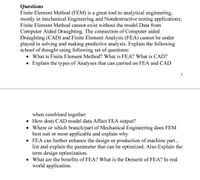
Elements Of Electromagnetics
7th Edition
ISBN: 9780190698614
Author: Sadiku, Matthew N. O.
Publisher: Oxford University Press
expand_more
expand_more
format_list_bulleted
Concept explainers
Question

Transcribed Image Text:Questions
Finite Element Method (FEM) is a great tool to analytical engineering,
mostly in mechanical Engineering and Nondestructive testing applications;
Finite Element Method cannot exist without the model Data from
Computer Aided Draughting. The connection of Computer aided
Draughting (CAD) and Finite Element Analysis (FEA) cannot be under
played in solving and making predictive analysis. Explain the following
school of thought using following set of questions:
• What is Finite Element Method? What is FEA? What is CAD?
• Explain the types of Analyses that can carried on FEA and CAD
1
when combined together
• How does CAD model data Affect FEA output?
• Where or which branch/part of Mechanical Engineering does FEM
best suit or most applicable and explain why
• FEA can further enhance the design or production of machine part ,
list and explain the parameter that can be optimized. Also Explain the
term design optimization.
• What are the benefits of FEA? What is the Demerit of FEA? In real
world application.
Expert Solution
This question has been solved!
Explore an expertly crafted, step-by-step solution for a thorough understanding of key concepts.
Step by stepSolved in 4 steps

Knowledge Booster
Learn more about
Need a deep-dive on the concept behind this application? Look no further. Learn more about this topic, mechanical-engineering and related others by exploring similar questions and additional content below.Similar questions
- explains how the two methods of parameter estimation, namely the method of parameter estimation and the method of moments and percentile matching, are used to fit distributions to data for actuarial calculations.arrow_forwardThe rapid progress of engineering design and information technology has caused difficulties in analyzing system reliability. Because of the increased complexity in system reliability structure (component/subsystem interfaces), many unexpected failure modes could occur, and their behaviors are interdependent. At a system’s design and development stage, the main challenge in analyzing a complex system is the failure uncertainty introduced by the incomplete knowledge of the system. This makes it hard to decompose system reliability into subsystem/component reliability in a deterministic manner, such as series or parallel systems. As a result, some common reliability analysis tools such as fault tree (FT) and reliability block diagram (RBD) become inadequate. Do you agree, why or why not? Are there any other approaches to system reliability assessment beside these tools at the early system’s design and development stage (what are these approaches)?arrow_forward
Recommended textbooks for you
 Elements Of ElectromagneticsMechanical EngineeringISBN:9780190698614Author:Sadiku, Matthew N. O.Publisher:Oxford University Press
Elements Of ElectromagneticsMechanical EngineeringISBN:9780190698614Author:Sadiku, Matthew N. O.Publisher:Oxford University Press Mechanics of Materials (10th Edition)Mechanical EngineeringISBN:9780134319650Author:Russell C. HibbelerPublisher:PEARSON
Mechanics of Materials (10th Edition)Mechanical EngineeringISBN:9780134319650Author:Russell C. HibbelerPublisher:PEARSON Thermodynamics: An Engineering ApproachMechanical EngineeringISBN:9781259822674Author:Yunus A. Cengel Dr., Michael A. BolesPublisher:McGraw-Hill Education
Thermodynamics: An Engineering ApproachMechanical EngineeringISBN:9781259822674Author:Yunus A. Cengel Dr., Michael A. BolesPublisher:McGraw-Hill Education Control Systems EngineeringMechanical EngineeringISBN:9781118170519Author:Norman S. NisePublisher:WILEY
Control Systems EngineeringMechanical EngineeringISBN:9781118170519Author:Norman S. NisePublisher:WILEY Mechanics of Materials (MindTap Course List)Mechanical EngineeringISBN:9781337093347Author:Barry J. Goodno, James M. GerePublisher:Cengage Learning
Mechanics of Materials (MindTap Course List)Mechanical EngineeringISBN:9781337093347Author:Barry J. Goodno, James M. GerePublisher:Cengage Learning Engineering Mechanics: StaticsMechanical EngineeringISBN:9781118807330Author:James L. Meriam, L. G. Kraige, J. N. BoltonPublisher:WILEY
Engineering Mechanics: StaticsMechanical EngineeringISBN:9781118807330Author:James L. Meriam, L. G. Kraige, J. N. BoltonPublisher:WILEY

Elements Of Electromagnetics
Mechanical Engineering
ISBN:9780190698614
Author:Sadiku, Matthew N. O.
Publisher:Oxford University Press

Mechanics of Materials (10th Edition)
Mechanical Engineering
ISBN:9780134319650
Author:Russell C. Hibbeler
Publisher:PEARSON

Thermodynamics: An Engineering Approach
Mechanical Engineering
ISBN:9781259822674
Author:Yunus A. Cengel Dr., Michael A. Boles
Publisher:McGraw-Hill Education

Control Systems Engineering
Mechanical Engineering
ISBN:9781118170519
Author:Norman S. Nise
Publisher:WILEY

Mechanics of Materials (MindTap Course List)
Mechanical Engineering
ISBN:9781337093347
Author:Barry J. Goodno, James M. Gere
Publisher:Cengage Learning

Engineering Mechanics: Statics
Mechanical Engineering
ISBN:9781118807330
Author:James L. Meriam, L. G. Kraige, J. N. Bolton
Publisher:WILEY